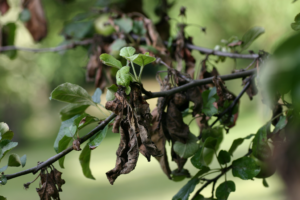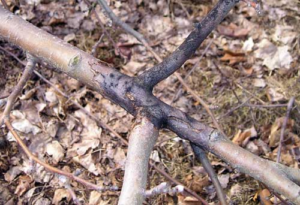Fire Blight
What is Fire Blight?
It is a destructive bacterial disease that affects plants in the rose family, including pear, crabapple, mountain ash, apple, rose, and spirea. Fire blight is caused by a bacteria called Erwinia amylovor.
Appearance
It gets its name from the scorched appearance of infecting leaves. The leaves will wilt and bend downward forming a dark brown or black color as seen in the picture; the leaves will die but not fall off. The most damage occurs when weather is warm, humid or rainy. After high winds and heavy rain damage to the tree can create open wounds where the bacteria can enter making the tree susceptible to the disease.
How does it spread?
Cells of the bacteria survive primarily in the cankers margins. Cankers are areas of dead tissue. When the humidity is high the bacteria oozes out of the canker margins. This ooze is a food source for insects who then move the ooze to wounds and flowers. Bacteria can also be moved by hands or tools. Disinfect tools after use.
Treatment
There is no cure for fire blight, but to avoid the disease from spreading the following can be done:
• Plant varieties resistant to fire blight
• Prune diseased branches in winter when the plant & bacteria is dormant
◦ Always disinfect tools after pruning
◦ Burn the diseased branches
• Avoid heavy pruning & excessive nitrogen fertilization (both encourage new growth & new growth will be susceptible to Fire Blight).
*To read more about Fire Blight visit the University of WI.
